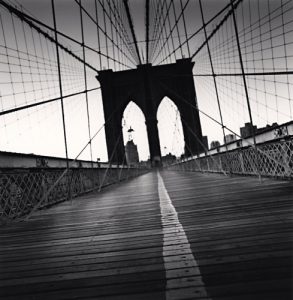This is a photo called “Brooklyn Bridge, Study 4, New York City, USA, 2000” which was caught by Michael Kenna. Michael Kenna is an English photographer who is known best for his black and white, unusual, landscapes with ethereal light achieved by photographing at dawn or at night with exposures of up to 10 hours. The image is taken on an empty Brooklyn bridge in black and white and makes the viewer think a little longer on his intention with this piece of artwork. I believe that Michael Kenna’s intention with this image is to make people think of life as a never-ending bridge. That is due to how the bride seems to not have any ending. The mood or feeling that this image is tense. That is because the bridge gives the appearance of it being never-ending. The “Brooklyn Bridge, Study 4, New York City, USA, 2000” by Michael Kenna contains three of the nine formal elements, and those are Leading Lines, Diagonals, and Symmetry.
Leading Lines are one of the most effective and under-utilized compositional tools available to photographers. They’re used to draw a viewer’s attention to a specific part of the frame, whether it’s a person, or a vanishing point in the background of the frame. This is very clearly seen where the two corners of the bridge move to the center of the photograph. Diagonals are a slanting straight pattern or line. Which can be seen in the support wires that hold up the bridge. Symmetry the quality of being made up of exactly similar parts facing each other or around an axis or exact correspondence between different things. Which can be seen if the image is folded or cut in half, and the two pieces will be identical to each other. These three formal elements are prefect to analyze this image.




This is a good example of leading lines the perspective lines of the bridge lead to its iconic forms. Leading lines need to lead to the most important area in the photo.